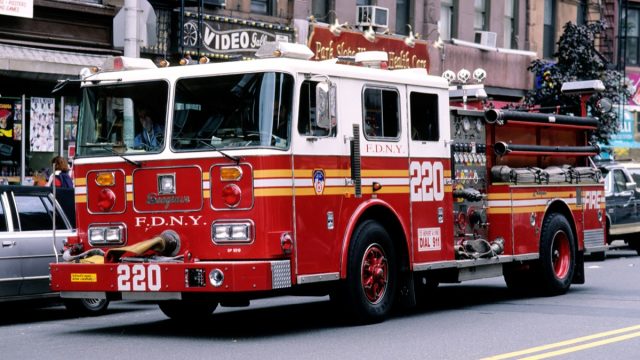This Is Why Fire Trucks Are Red

When you think of a fire truck, it’s highly unlikely you picture it any color but red. Sure, there are exceptions in the U.S., and many other western nations, where you’ll find white, yellow, and even pink fire response vehicles—but red has been the default color of fire trucks going back to the early days of organized fire departments. And if you’ve ever wondered why fire trucks are red, the answer will surprise you.
Now, if your first guess is that fire brigades chose the striking, hard-to-miss color because it’s more noticeable than others and helps to somehow reduce the frequency of accidents, you would be mistaken. In fact, a 1995 study on the role played by color in fire vehicle accidents, published in The Journal of Safety Research, found that controlling for other factors, red fire trucks are actually more likely to be involved in accidents and are less visible than yellow or green trucks. (Weird, right?)
The color was instead most likely was adopted for less practical, more aesthetic reasons: competition between early firefighting brigades.
Organized fire departments began in the early 1800s (though “organized” is a relative term) as groups of volunteers emerged that more closely resembled rival gangs than the dedicated and highly trained emergency responders of today.
“There were rivalries in cities like New York and Baltimore where fire companies would go at it and be on opposite sides of civil unrest,” Timothy Winkle, deputy chair and curator of the division of home and community life at the Smithsonian’s National Museum of American History, told Smithsonian.
These groups would compete with one another for who could get to an emergency first, and would often fight each other on the scene for the right to put out the blaze. And one of the main sources of pride for these groups? Their fire pumps, which were decorated with the squad’s insignia, and the bright color of their truck.
“Each brigade wanted their rig stand out by being the cleanest, having the most brass, or being a regal color,” as a writer for the City of Muskogee, OK, puts it. Whether because red was the most expensive color at the time, or just seen as the flashiest and strongest, it was soon adopted by many of these groups, and the practice continued as fire departments became more formalized throughout the country.
It bears mentioning that some historians disagree with this explanation, however. Gary Urbanowicz, executive director of the New York Fire Museum, his his doubts.
“There really is no documentation on it,” he says, though he agrees that making a fire engine stand out was a major concern of the early firefighting groups.
Whatever the case, if you want to know why fire trucks are red—or why fire trucks stayed red—just look at what firefighters in Santa Monica, CA, had to say when, after 15 years of using chartreuse-colored response vehicles that research said were safer, the city returned to the classic red color.
“They’re real proud to have red again,” Santa Monica’s deputy fire chief, Ettore Berardinell, told the Los Angeles Times at the time. “A lot of people will laugh at that, but . . . I’m not making this up.”
Incidentally, if you ask Siri this question, she will offer you this lengthy explanation:
“Because they have eight wheels and four people on them, and four plus eight is 12, and there are 12 inches in a foot, and one foot is a ruler, and Queen Elizabeth was a ruler, and Queen Elizabeth was also a ship, and the ship sailed the seas, and in the seas are fish, and fish have fins, and the Finns fought the Russians, and the Russians are red, and fire trucks are always ‘russian’ around.”
Go figure!
And for more amazing facts about the world around you, check out these 50 Amazing Facts About Everyday Objects!
To discover more amazing secrets about living your best life, click here to follow us on Instagram!